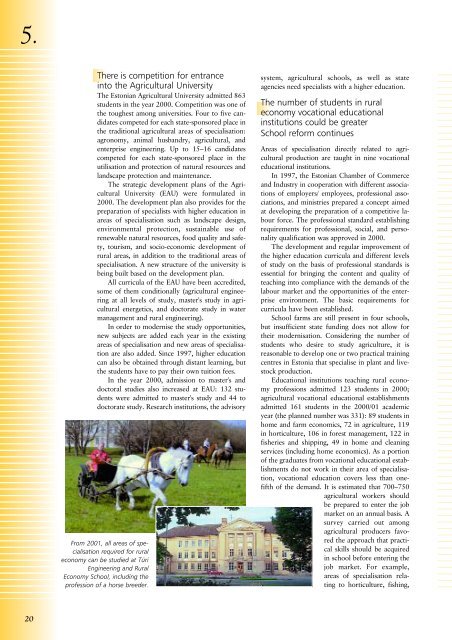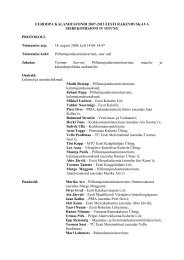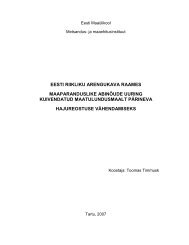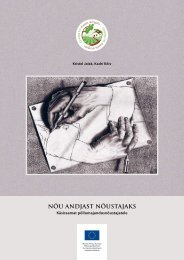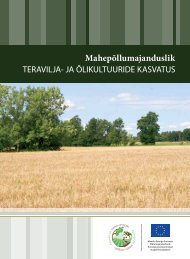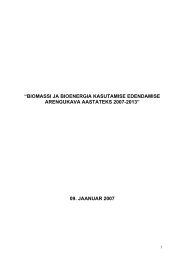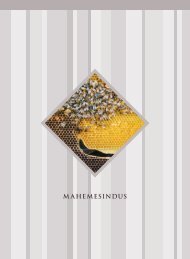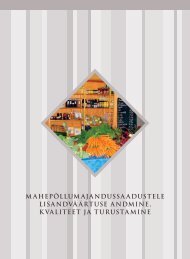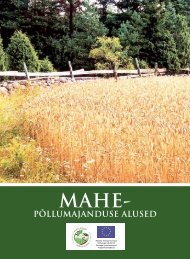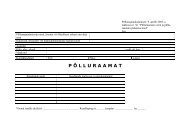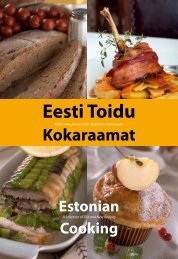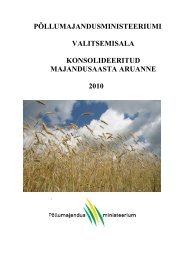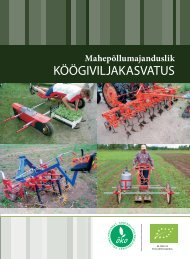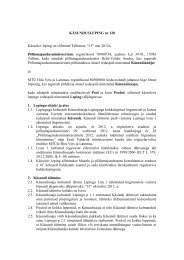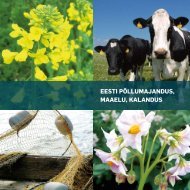estonian agriculture, rural economy and food industry
estonian agriculture, rural economy and food industry
estonian agriculture, rural economy and food industry
Create successful ePaper yourself
Turn your PDF publications into a flip-book with our unique Google optimized e-Paper software.
5.<br />
There is competition for entrance<br />
into the Agricultural University<br />
The Estonian Agricultural University admitted 863<br />
students in the year 2000. Competition was one of<br />
the toughest among universities. Four to five c<strong>and</strong>idates<br />
competed for each state-sponsored place in<br />
the traditional agricultural areas of specialisation:<br />
agronomy, animal husb<strong>and</strong>ry, agricultural, <strong>and</strong><br />
enterprise engineering. Up to 15–16 c<strong>and</strong>idates<br />
competed for each state-sponsored place in the<br />
utilisation <strong>and</strong> protection of natural resources <strong>and</strong><br />
l<strong>and</strong>scape protection <strong>and</strong> maintenance.<br />
The strategic development plans of the Agricultural<br />
University (EAU) were formulated in<br />
2000. The development plan also provides for the<br />
preparation of specialists with higher education in<br />
areas of specialisation such as l<strong>and</strong>scape design,<br />
environmental protection, sustainable use of<br />
renewable natural resources, <strong>food</strong> quality <strong>and</strong> safety,<br />
tourism, <strong>and</strong> socio-economic development of<br />
<strong>rural</strong> areas, in addition to the traditional areas of<br />
specialisation. A new structure of the university is<br />
being built based on the development plan.<br />
All curricula of the EAU have been accredited,<br />
some of them conditionally (agricultural engineering<br />
at all levels of study, master's study in agricultural<br />
energetics, <strong>and</strong> doctorate study in water<br />
management <strong>and</strong> <strong>rural</strong> engineering).<br />
In order to modernise the study opportunities,<br />
new subjects are added each year in the existing<br />
areas of specialisation <strong>and</strong> new areas of specialisation<br />
are also added. Since 1997, higher education<br />
can also be obtained through distant learning, but<br />
the students have to pay their own tuition fees.<br />
In the year 2000, admission to master's <strong>and</strong><br />
doctoral studies also increased at EAU: 132 students<br />
were admitted to master's study <strong>and</strong> 44 to<br />
doctorate study. Research institutions, the advisory<br />
From 2001, all areas of specialisation<br />
required for <strong>rural</strong><br />
<strong>economy</strong> can be studied at Türi<br />
Engineering <strong>and</strong> Rural<br />
Economy School, including the<br />
profession of a horse breeder.<br />
system, agricultural schools, as well as state<br />
agencies need specialists with a higher education.<br />
The number of students in <strong>rural</strong><br />
<strong>economy</strong> vocational educational<br />
institutions could be greater<br />
School reform continues<br />
Areas of specialisation directly related to agricultural<br />
production are taught in nine vocational<br />
educational institutions.<br />
In 1997, the Estonian Chamber of Commerce<br />
<strong>and</strong> Industry in cooperation with different associations<br />
of employers/ employees, professional associations,<br />
<strong>and</strong> ministries prepared a concept aimed<br />
at developing the preparation of a competitive labour<br />
force. The professional st<strong>and</strong>ard establishing<br />
requirements for professional, social, <strong>and</strong> personality<br />
qualification was approved in 2000.<br />
The development <strong>and</strong> regular improvement of<br />
the higher education curricula <strong>and</strong> different levels<br />
of study on the basis of professional st<strong>and</strong>ards is<br />
essential for bringing the content <strong>and</strong> quality of<br />
teaching into compliance with the dem<strong>and</strong>s of the<br />
labour market <strong>and</strong> the opportunities of the enterprise<br />
environment. The basic requirements for<br />
curricula have been established.<br />
School farms are still present in four schools,<br />
but insufficient state funding does not allow for<br />
their modernisation. Considering the number of<br />
students who desire to study <strong>agriculture</strong>, it is<br />
reasonable to develop one or two practical training<br />
centres in Estonia that specialise in plant <strong>and</strong> livestock<br />
production.<br />
Educational institutions teaching <strong>rural</strong> <strong>economy</strong><br />
professions admitted 123 students in 2000;<br />
agricultural vocational educational establishments<br />
admitted 161 students in the 2000/01 academic<br />
year (the planned number was 331): 89 students in<br />
home <strong>and</strong> farm economics, 72 in <strong>agriculture</strong>, 119<br />
in horticulture, 106 in forest management, 122 in<br />
fisheries <strong>and</strong> shipping, 49 in home <strong>and</strong> cleaning<br />
services (including home economics). As a portion<br />
of the graduates from vocational educational establishments<br />
do not work in their area of specialisation,<br />
vocational education covers less than onefifth<br />
of the dem<strong>and</strong>. It is estimated that 700–750<br />
agricultural workers should<br />
be prepared to enter the job<br />
market on an annual basis. A<br />
survey carried out among<br />
agricultural producers favored<br />
the approach that practical<br />
skills should be acquired<br />
in school before entering the<br />
job market. For example,<br />
areas of specialisation relating<br />
to horticulture, fishing,<br />
20


